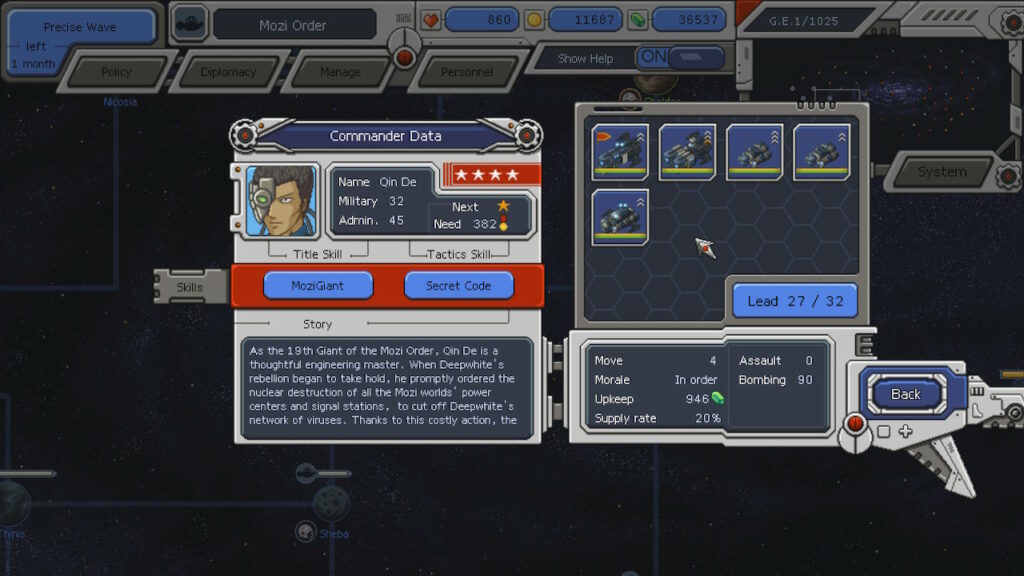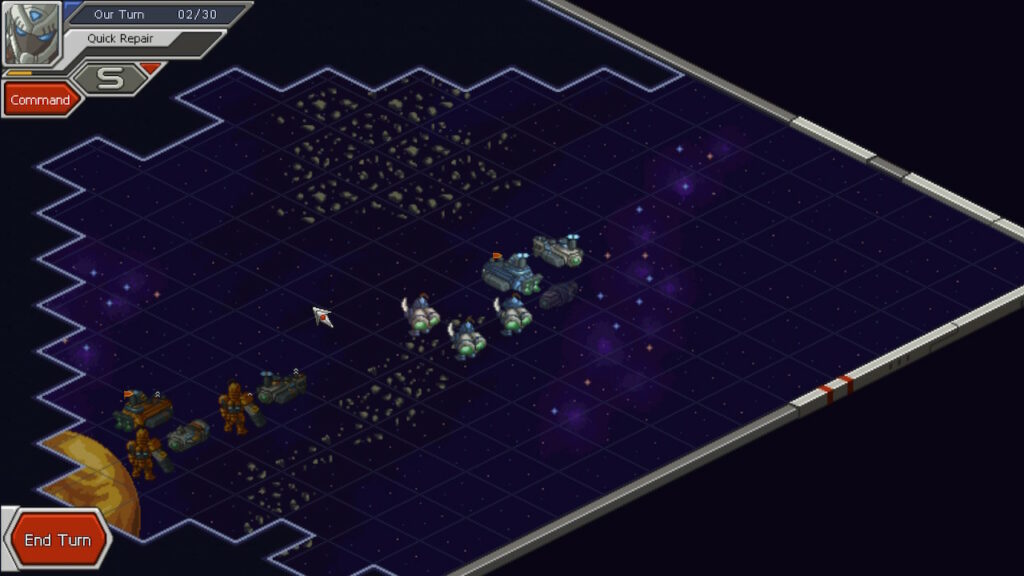Review: Chaos Galaxy
When I was much younger, I very much enjoyed Koei’s weird brand of grand strategy game. Being focused on personalities over numbers, tech trees or deep city-building makes them feel a little lighter on strategy than even the Civilization games coming out around the same time. In retrospect, though, they were fairly deep while still being well tuned to a console experience. The “officer” layer adds another level of management, as well as some personality – even a portrait and a couple of numbers can go a long way towards making a character feel more real. This in turn adds a bit of additional flavor to the overall experience, which might make it feel more tolerable when – for example – playing as Chrysalis and Flax in Gemfire are much the same experience after you’ve surpassed the threats in the first few hours.

Chaos Galaxy (which I played on Switch, but is also available on PC along with its sequel) channels much of the same feel as those games, while adding some helpful tactical depth.
The strategy layer will seem somewhat familiar to veterans of the subgenre, since there’s a large “world map” with star systems that can be owned and improved. The addition of “skills” unique to each admiral (and generic ones added at level-up, similar to Heroes of Might & Magic) adds a little to it, with some of those skills affecting the strategy layer. The tactical layer is more interesting since each admiral also has a unique ability in battles, and each faction has units unique to it accessible via the faction’s unique skill tree – so particular admirals may be more or less effective depending on which faction you are.
When in the strategic mode, the actions you can take might seem somewhat limited compared to other grand strategy games. Each fleet (admiral) can move and optionally attack, recruit or disband units, or train. You can also take one diplomatic action per faction (although a vassal state may only interact with its liege), and spend money to research or develop planet stats (I called them “star systems” above, since some of the lore implies each is several planets, but each is represented by a planet icon; for simplicity, I’m calling them planets). Each admiral can also be assigned to govern one planet, with a separate Administration stat affecting planet growth. Planet stats also improve naturally, albeit more slowly, and money is limited in the first third of a campaign, so you’re likely to want to improve only the planets that give you the best bang for your buck (those with administrative bonuses or high stats, planets with bonuses to specific investment types, or those with a yearly goal attached).
This simplicity of the strategy layer is a blessing and a curse. By auto-resolving battles, it’s possible to blitz through the mid-game relatively quickly, but it also makes the strategy layer feel a bit empty or non-consequential when there are few actions you can take domestically. By the mid-game, planetary development becomes more tedious – some kind of automation / delegation function would have been very welcome. Research makes things a little more interesting, but by the time enough money is available to pursue research consistently (particularly the most advanced faction-unique unit types) the outcome of the campaign is likely already decided. The opposing AI is just not smart enough to handle the player in most circumstances. While you can play as a faction that has a harder start, or attempt some of the alternate objectives available, this will only make the early game difficult and the mid-to-late game is largely unchanged.

Tactical combat has the highs and lows of games like Advance Wars; there’s a fair bit of boring traversal, but once you’re locked in combat with your foes it is quite fun – the submarine “dive” mechanic can be a joy to use, particularly if you manage to set up a satisfying ambush. While the AI opponent clearly knows where your subs are, you can guess within a few spaces of where theirs are when they attack (since the screen briefly zooms on the active unit, and you know which weapon was used against your ships). Different units don’t have hard rock-paper-scissors advantages against others, but they do incentivize using a variety of units weighted towards which admiral or faction you’re using. I personally much prefer this to hard-counter style play, as you can work more towards your preferences vs. specifically tracking what your enemy is using and building to counter.
The setup for Chaos Galaxy is worth a mention. Some of Koei’s strategic simulations had multiple start dates to allow for many different starts. Chaos Galaxy opts instead for around a dozen playable factions, many of which have similar-ish setups (for example, the four almost-symmetrical imperial vassals). Overall the player’s strategy-layer is likely to be fairly similar between factions, while the preferred fleet units and tactical play are likelier to be different based on their faction choice. Variations in starting position as well as events early on give players plenty of options and variables to work with.
While the backstory to the game doesn’t quite have the rich roster of Romance of the Three Kingdoms, it’s fairly well-written. Phrasing is somewhat awkward in places but gets the point across. As I get older, I have a little bit more patience for this – it’s a hard (or expensive) thing to get right, and here it is more than right-enough. If I had a complaint regarding the in-game flavor, it is that almost every character is written in a neutral-to-favorable tone (including those that greenlit major atrocities, such as the near-total destruction of an imperial vassal faction). It’s perhaps the intent to allow the player to make the judgement regarding who is right or wrong and treat the backstory as more of a historical record. This also gives players a bit of a blank slate with respect to faction leaders – outside of a few outliers like the robot faction, the actual objectives of each faction leader aren’t specifically stated. Many of the factions do take a fairly one-note approach to characterization (the five sub-factions of the Imperials are China-inspired, the mercenary factions are Greek, etc) but given the limitations involved with a single person responsible for much of the game, it’s understandable.
The Switch port in particular has a couple of features that are unusual for a Switch game. It heavily incentivizes using the touchscreen. The only way to reliably speed through text is by tapping the screen, and the cursor speed is not configurable. Using the joystick to move the cursor across the screen takes a few seconds, so it’s much preferable to just tap. Some button shortcuts are available, but (for example) the d-pad cycles through your units regardless of whether they have taken their turn. Some minor tweaks to some of these things would vastly improve the overall experience.
I enjoyed my time with Chaos Galaxy, and already added its sequel to my Steam wishlist. Well worth the price of entry, even at the slightly higher Switch price point.